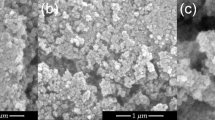Abstract
Metal oxide (ZrO2) nanoparticle-dispersed polymer films (hybrid latex films) were prepared from polymer particles incorporating ZrO2 nanoparticles (hybrid latex dispersion). The hybrid latex dispersions were synthesized by miniemulsion polymerization. The resulting films were transparent, and they derived their properties from the ZrO2 nanoparticles. The refractive indexes of the films increased with the ZrO2 content. Surface-modified ZrO2 nanoparticles were dispersed successfully in a polymer matrix containing phosphoric acid groups, which interacts with the surfaces of the ZrO2 nanoparticles and increases the compatibility between the polymer and ZrO2.




Similar content being viewed by others
Notes
The contrast of acryl polymer component is lower than that of ZrO2 and the acryl polymer particles are easy to coalesce. The images of the isolated particles (left) and the packed particles (right) are shown for 1a. In the hybrid particles 1–5, 7, 8 except 1c, the acryl polymer component (acryl polymer particle) is barely identified.
n-Butyl acrylate and ethylene glycol methacrylate phosphate, which is a typical commercial available monomer having phosphoric acid group, were immiscible. This will be for the difference of polarity between the monomers. In contrast, PGMP was miscible with n-butyl acrylate probably owing to the polypropylene glycol chain, and could increase the compatibility between the acrylic polymer and ZrO2 to form transparent hybrid films as described above. However, in the hybrid film prepared from 4, the excess amount of the phosphoric acid group of PGMP might potentially aggregate and cause the phase separation even in the presence of the polypropylene glycol chain.
References
M. Inkyo, Y. Tokunaga, T. Tahara, T. Iwaki, F. Iskandar, C.J. Hogan Jr., K. Okuyama, Ind. Eng. Chem. Res. 47, 2597 (2008)
Y. Imai, A. Terahara, Y. Hakuta, K. Matsui, H. Hayashi, N. Ueno, Eur. Polym. J. 45, 630 (2009)
S. Yamada, Z. Wang, K. Yoshinaga, Chem. Lett. 38, 828 (2009)
D. Nagao, T. Kinoshita, A. Watanabe, M. Konno, Polym. Int. 60, 1180 (2011)
H.I. Elim, B. Cai, Y. Kurata, O. Sugihara, T. Kaino, T. Adschiri, A.L. Chu, N. Kambe, J. Phys. Chem. B 113, 10143 (2009)
T. Suzuki, Y. Ito, B. Boury, Y. Sugahara, Chem. Lett. 36, 856 (2007)
Y. Minami, K. Murata, S. Watase, K. Matsukawa, Kobunshi Ronbunshu 67, 397 (2010)
T. Tamai, M. Watanabe, Y. Minami, S. Okazaki, A. Masuyama, K. Matsukawa, Chem. Lett. 40, 37 (2011) (preliminary communication)
E. Schreiber, U. Ziener, A. Manzke, A. Plettl, P. Ziemann, K. Landfester, Chem. Mater. 21, 1750 (2009)
D. Suzuki, H. Kawaguchi, Langmuir 21, 8175 (2005)
N. Yamauchi, D. Nagao, M. Konno, Colloid Polym. Sci. 288, 55 (2010)
A. Schmid, S. Fujii, S.P. Armes, C.A.P. Leite, F. Galembeck, H. Minami, N. Saito, M. Okubo, Chem. Mater. 19, 2435 (2007)
T. Tamai, M. Watanabe, Y. Hatanaka, H. Tsujiwaki, N. Nishioka, K. Matsukawa, Langmuir 24, 14203 (2008)
T. Tamai, M. Watanabe, H. Maeda, K. Mizuno, J. Polym. Sci. Part A 46, 1470 (2008)
H. Maeda, T. Maeda, K. Mizuno, K. Fujimoto, H. Shimizu, M. Inouye, Chem. Eur. J. 12, 824 (2006)
M.A. Winnik, in Emulsion Polymerization and Emulsion Polymers, ed. by P.A. Lovell, M.S. El-Aasser (Wiley, New York, 1997), p. 467
T. Tamai, P. Pinenq, M.A. Winnik, Macromolecules 32, 6102 (1999)
M. Watanabe, T. Tamai, Langmuir 23, 3062 (2007)
H. Luo, C.M. Cardinal, L.E. Scriven, L.F. Francis, Langmuir 24, 5552 (2008)
P.H. Mutin, G. Guerrero, A. Vioux, J. Mater. Chem. 15, 3761 (2005)
C.J. Lomoschitz, B. Feichtenschlager, N. Moszner, M. Puchberger, K. Muller, M. Abele, G. Kickelbick, Langmuir 27, 3534 (2011)
A. Zeller, A. Musyanovych, M. Kappl, A. Ethirajan, M. Dass, D. Markova, M. Klapper, K. Landfester, ACS Appl. Mater. Interface 2, 2421 (2010)
D.E. Aspnes, Am. J. Phys. 50, 704 (1982)
Acknowledgments
This study was partly supported by a Grant-in-Aid for Scientific Research (C) (22550138) from the Ministry of Education, Culture, Sports, Science and Technology of Japan. We thank Uni-Chemical Co. Ltd. for providing chemicals.
Author information
Authors and Affiliations
Corresponding author
Rights and permissions
About this article
Cite this article
Tamai, T., Okazaki, S., Watanabe, M. et al. Hybrid films prepared from latex particles incorporating metal oxide nanoparticles. Res Chem Intermed 39, 291–300 (2013). https://doi.org/10.1007/s11164-012-0649-z
Received:
Accepted:
Published:
Issue Date:
DOI: https://doi.org/10.1007/s11164-012-0649-z




